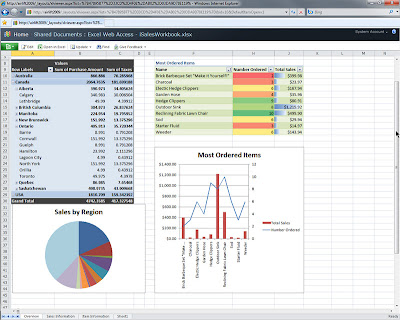SharePoint 2010

With a public beta still a few weeks away, Microsoft used its recent SharePoint conference in Las Vegas to unveil the upcoming 2010 release of its collaboration and content management suite. The most obvious change is the name – SharePoint is no longer part of the Office family, even though it’s the intranet host for the Office 2010 Web Apps. It’ll also be offered in on-premises or hosted versions. Microsoft is taking SharePoint very seriously indeed – it’s now a $1.3 billion business for the company – and it’s investing strongly in supporting a growing SharePoint ecosystem.
The 2010 release will be a major upgrade from SharePoint 2007. First and foremost it’s a 64-bit application. That’s a big change for anyone using SharePoint on 32-bit servers, as it’ll mean an OS (and probably a hardware) upgrade. Then there are the UI changes, which may make updating pages an issue. The new SharePoint UI is based on the Office 2010 look-and-feel, and brings the Office ribbon into SharePoint pages. The ribbon will be contextual, so will only appear when it’s needed (usually when you’re editing content). Users get access to social networking tools, and there’s plenty of scope for customisation. Integration with Microsoft’s FAST enterprise search tools adds to SharePoint’s enterprise content management features, and ties in with the platform’s social networking features to target search results based on the previous queries from team members and peers.

SharePoint 2010 hosts the on-premises versions of the Office 2010 Web Apps
The underlying architecture has had a significant update. Built using SOA principles, it mixes shared service components with Microsoft’s Windows Communications Framework. At a higher level there’s support for managed workflows, and for developers to use Web 2.0 development techniques (including REST for HTTP access) as well as building components and services in Visual Studio. There’s also support for Silverlight, both for video streaming and for your own video streaming components. Business analysts can use SharePoint Designer 2010 and Visio to build workflows, and can also take advantage of SharePoint’s upgraded Business Connectivity Services to connect line of business applications to SharePoint and Office (Outlook and Word) without having to write any code.

SharePoint 2010's Business Connectivity Services link any web service enabled application to SharePoint or Office - without any code.
SharePoint’s always been used to host Internet and extranet sites, and these aspects get a significant upgrade – focusing on the content management features of the tools. Extranet sites can also participate in business processes, using SharePoint workflows to manage the flow of information to and from partners and customers. Microsoft will have separate SKUs for Internet-facing SharePoint installations, whether hosted online or on-premises.
The beta should be publicly available from the middle of November - Microsoft is currently upgrading all its internal SharePoint servers and sites to SharePoint 2010, and plans to use this process to identify any significant bugs or issues.
Simon Bisson